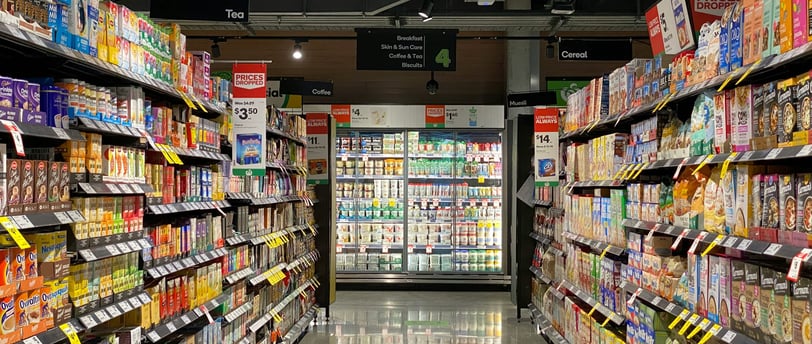Ultra-Processed Foods: What They Are, Their Risks, and How to Spot Them
Ultra-processed foods dominate supermarket shelves in New Zealand, but are they harming your health? Learn what UPFs are, their risks, and how to spot them on food labels to make smarter, healthier choices.
Nick Godfrey
2/25/20253 min read


Ultra-processed foods (UPFs) are everywhere in New Zealand—from supermarket shelves to fast-food chains. But what exactly are they, and how do they impact our health? This article will break down what UPFs are, their benefits and risks, their prevalence in New Zealand, and how to identify them on food labels. We'll also dive deep into common ultra-processed ingredients and the potential health risks associated with each.
What Are Ultra-Processed Foods?
Ultra-processed foods (UPFs) are industrial formulations made primarily from substances extracted or derived from food, combined with additives such as preservatives, emulsifiers, and artificial flavors. They typically are packaged and contain more than 5 ingredients with minimal to no whole foods.
In New Zealand, nearly 70% of packaged foods in supermarkets are classified as ultra-processed. Research shows that UPFs dominate supermarket shelves, making it challenging for us to avoid them. These include many household staple brands such as Kellogg's and Nestle which up to 90% of their product portfolio are UPFs.
Benefits of Ultra-Processed Foods?
Despite their drawbacks these foods can provide a lifeline for impoverished families in New Zealand and can reduce food insecurity. UPFs offer certain advantages:
Convenience: Ready-to-eat or quick-to-prepare foods save time, making them appealing for busy individuals.
Affordability: Mass production and cheaper ingredients make UPFs more accessible, particularly for lower-income households.
Extended Shelf Life: Preservatives prevent spoilage, reducing food waste and making them more reliable for storage.
Despite this, several factors contribute to the high consumption of UPFs among lower-income households in NZ:
Economic Constraints: UPFs are often cheaper than fresh, minimally processed foods.
Time Limitations: Working multiple jobs or balancing responsibilities can make quick meals more appealing.
Aggressive Marketing: UPFs are heavily promoted, often with discounts, making them more attractive to budget-conscious consumers.
Health Risks of Ultra-Processed Foods
These factors contribute to the frequent consumption of UPFs which have been linked to several health concerns:
Nutrient Deficiencies: High in calories but low in essential nutrients like fiber, vitamins, and minerals.
Obesity and Metabolic Disorders: Studies show a strong correlation between UPFs and weight gain, type 2 diabetes, and metabolic syndrome.
Cardiovascular Disease: Diets high in UPFs increase the risk of heart disease due to their high levels of added sugars, unhealthy fats, and sodium.
Mental Health Issues: Emerging research suggests a link between UPFs and increased rates of depression and anxiety.
What to look out for?
To spot UPFs, check for the following on food packaging in New Zealand:
Long Ingredient Lists: The more ingredients—especially unfamiliar ones—the more processed the food is.
Artificial Additives: Look for preservatives, emulsifiers, artificial sweeteners, and food colorings.
Highly Refined Ingredients: Protein isolates, modified starches, and hydrogenated oils indicate high processing.
Misleading Health Claims: “Low fat,” “high protein,” or “sugar-free” labels can disguise the fact that a food is ultra-processed.
Although the Health Star Rating system provides some guidance, it does not indicate how processed a food is. Reading ingredient lists remains the best way to avoid UPFs.
If you want to shop a bit smarter, here's what ingredients to look out for in UPFs that may pose long term health risks.
1. High-Fructose Corn Syrup (HFCS)
What it is: A liquid sweetener derived from corn starch, high in fructose.
Why it’s used: Enhances sweetness and shelf life in soft drinks, baked goods, and snacks.
Health risks: Linked to obesity, insulin resistance, and fatty liver disease.
2. Hydrogenated Oils (Trans Fats)
What they are: Oils chemically altered to become solid at room temperature.
Why they’re used: Improve texture, enhance flavor stability, and extend shelf life.
Health risks: Increase bad cholesterol (LDL), reduce good cholesterol (HDL), and contribute to heart disease.
3. Monosodium Glutamate (MSG)
What it is: A flavor enhancer providing an umami taste.
Why it’s used: Intensifies flavors in processed meats, snacks, and soups.
Health risks: Some individuals report headaches and metabolic disturbances, though evidence is inconclusive.
While ultra-processed foods offer convenience and affordability, their long-term health effects make them a risky dietary staple. With nearly 70% of supermarket products in New Zealand classified as UPFs, consumers must be mindful of ingredient lists and processing levels. By prioritizing whole, minimally processed foods, individuals can make healthier choices and reduce their reliance on UPFs.


